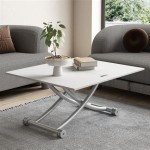Lift Top Coffee Table Springs: A Comprehensive Guide
The lift top coffee table has emerged as a popular furniture choice, offering versatility and space-saving functionality within a living room setting. A crucial component enabling this functionality is the spring mechanism that facilitates the lifting and lowering of the tabletop. Understanding the different types of lift top coffee table springs, their mechanisms, benefits, and potential drawbacks is essential for both consumers considering purchasing such a table and manufacturers designing and building them.
These springs are responsible for providing the necessary counter-balance and controlled movement required to smoothly elevate the tabletop. Without properly functioning springs, the lift top mechanism would be difficult to operate, potentially leading to uneven lifting, abrupt dropping, or even a complete failure in the lifting function. The selection of appropriate springs, therefore, directly impacts the user experience and the overall durability of the coffee table.
This article delves into the world of lift top coffee table springs, exploring their various types, the mechanics of their operation, key considerations for selection, potential issues, and maintenance strategies. This information aims to provide a clear and informative understanding of this essential component.
Types of Lift Top Coffee Table Springs
Several types of springs are used in lift top coffee table mechanisms, each with its own advantages and disadvantages. The best choice depends on the specific design of the table, the weight and dimensions of the tabletop, and the desired lifting characteristics.
Coil Springs: Coil springs are one of the most common types used in lift top coffee tables. These springs are helically wound and offer a linear spring rate, meaning the force required to compress the spring increases proportionally with the amount of compression. They are generally durable and reliable, providing consistent performance over their lifespan. Coil springs are available in various sizes and strengths, allowing for customized adjustment based on the weight of the tabletop. The construction of coil springs can vary, with options including different wire thicknesses, coil diameters, and spring lengths. Higher quality coil springs are typically made from hardened steel to ensure optimal durability and resistance to fatigue. The placement of coil springs within the lifting mechanism can also vary, with some designs utilizing a single large spring while others employ multiple smaller springs to distribute the load more evenly.
Gas Springs: Gas springs, also known as gas struts or gas shocks, offer a smoother and more controlled lifting experience compared to traditional coil springs. These springs utilize compressed gas within a cylinder to provide the lifting force. The gas acts as a cushion, preventing abrupt movements and ensuring a gentle and controlled ascent and descent of the tabletop. Gas springs also offer adjustable damping, which allows for fine-tuning the speed of the lifting and lowering action. This adjustability is particularly beneficial for heavier tabletops, as it can prevent the tabletop from slamming shut. However, gas springs are generally more expensive than coil springs and may require more complex installation. Furthermore, gas springs can potentially leak gas over time, which can reduce their effectiveness. The lifespan of gas springs can be affected by factors such as temperature variations and the frequency of use. Regular inspection of the gas springs for signs of leakage or damage is recommended to ensure optimal performance.
Leaf Springs: Leaf springs are less common in lift top coffee tables but can be found in some designs. These springs consist of multiple layers of thin steel plates stacked on top of each other. Leaf springs provide a progressive spring rate, meaning the force required to compress the spring increases at an increasing rate as the spring is compressed further. This progressive rate can be advantageous for heavier tabletops, as it provides greater resistance to compression as the tabletop is lifted. However, leaf springs tend to be bulkier than coil springs or gas springs and may not be suitable for all table designs. Leaf springs are also more prone to corrosion, which can reduce their lifespan and performance. Proper lubrication and maintenance are essential to prevent corrosion and ensure the reliable operation of leaf springs.
Torsion Springs: Torsion springs are rotational springs that resist twisting forces. While not commonly used as the primary lifting mechanism for lift top coffee tables, they can be incorporated into the hinges or other moving parts of the lifting mechanism to provide additional support or damping. Torsion springs are typically made from high-strength steel and are designed to withstand repeated twisting motions. Their compact size makes them suitable for use in confined spaces. The selection of the appropriate torsion spring depends on the torque required to resist the twisting force and the desired range of motion. Torsion springs are commonly found in situations where precise control of rotational movement is desired.
Mechanism and Functionality
The spring mechanism in a lift top coffee table is typically integrated into a metal frame that connects the tabletop to the base of the table. The springs are strategically positioned within this frame to provide the necessary lifting force and controlled movement. The mechanism generally operates through a system of hinges and linkages that translate the upward force of the springs into a vertical lifting motion of the tabletop. The design of the mechanism can vary depending on the type of springs used and the desired lifting characteristics.
When the tabletop is in the closed position, the springs are in a compressed state, storing potential energy. As the tabletop is lifted, the springs release this stored energy, assisting in the upward motion. The hinges and linkages guide the tabletop along a predetermined path, ensuring a smooth and controlled lifting action. The mechanism is designed to lock the tabletop in the raised position, providing a stable and functional surface for working or dining. To lower the tabletop, a release mechanism is typically engaged, allowing the springs to compress again and the tabletop to return to its original position.
The design of the lifting mechanism is crucial for ensuring the stability and safety of the coffee table. The frame must be strong enough to support the weight of the tabletop and any items placed on it. The hinges and linkages must be precisely aligned to prevent binding or excessive wear. The springs must be properly calibrated to provide the correct amount of lifting force. A well-designed mechanism will operate smoothly and quietly, providing a comfortable and user-friendly experience.
The geometry of the linkages also plays a significant role in the feel of the lift operation. Some designs prioritize a nearly vertical lift, while others opt for a more angled trajectory. The chosen trajectory affects the amount of reach required to use the raised surface and can influence the perceived stability of the table.
Key Considerations for Selecting Springs
Selecting the appropriate springs for a lift top coffee table is critical for ensuring its functionality, durability, and user satisfaction. Several factors should be considered during the selection process.
Weight of the Tabletop: The weight of the tabletop is the most important factor to consider. The springs must be strong enough to lift the tabletop without excessive effort but not so strong that the tabletop is difficult to lower. The spring rate, measured in force per unit of compression (e.g., pounds per inch), must be carefully matched to the weight of the tabletop. A heavier tabletop requires stronger springs with a higher spring rate. It is essential to accurately measure the weight of the tabletop, including any hardware or accessories that will be attached to it. Selecting springs that are too weak will result in a difficult lifting action, while springs that are too strong can make the tabletop feel stiff and unresponsive.
Size and Dimensions of the Tabletop: The size and dimensions of the tabletop also affect the spring selection. A larger tabletop requires stronger springs to support its weight and prevent sagging. The distribution of weight across the tabletop should also be considered. A tabletop with an uneven weight distribution may require springs with different spring rates to ensure a balanced lifting action. The placement of the springs within the lifting mechanism should be carefully considered to optimize the distribution of force and prevent uneven lifting. The overall footprint of the table base also constrains the potential placement and type of spring that can be effectively used.
Desired Lifting Characteristics: The desired lifting characteristics, such as the speed of the lifting action and the smoothness of the transition, should be considered. Gas springs offer a smoother and more controlled lifting experience compared to coil springs, but they are also more expensive. Coil springs can provide a more abrupt lifting action, but they are generally more durable and reliable. The spring rate can be adjusted to fine-tune the lifting characteristics. A lower spring rate will result in a slower and smoother lifting action, while a higher spring rate will result in a faster and more abrupt lifting action. The damping characteristics of the springs, if applicable, can also be adjusted to control the speed of the lifting and lowering action.
Durability and Lifespan: The durability and lifespan of the springs are also important considerations. Springs made from high-quality materials, such as hardened steel, will generally last longer and provide more consistent performance. The springs should be resistant to corrosion and fatigue. Regular maintenance, such as lubrication, can extend the lifespan of the springs. The frequency of use and the environmental conditions can also affect the lifespan of the springs. In high-humidity environments, corrosion-resistant springs are recommended. The expected lifespan of the springs should be considered when selecting springs for a lift top coffee table intended for long-term use.
Cost: The cost of the springs is another factor to consider. Gas springs are generally more expensive than coil springs, but they offer superior performance. The overall cost of the lifting mechanism, including the springs, frame, hinges, and linkages, should be considered when making a purchasing decision. The cost of the springs should be balanced against their performance, durability, and lifespan. It is important to choose springs that offer the best value for the intended application.
Ease of Installation and Adjustment: The ease of installation and adjustment should also be considered. Some spring mechanisms are easier to install and adjust than others. The availability of replacement parts should also be considered. It is important to choose a spring mechanism that can be easily installed, adjusted, and repaired. Clear and concise installation instructions are essential for ensuring a successful installation. The ability to adjust the spring tension or damping characteristics is beneficial for fine-tuning the lifting action.
Potential Issues and Maintenance
Despite their robust design, lift top coffee table springs can experience issues over time. Understanding these potential problems and implementing preventative maintenance can significantly extend the lifespan and performance of the table.
Spring Fatigue: Spring fatigue is a common issue that can occur over time, especially with coil springs. Repeated compression and extension of the springs can cause them to lose their elasticity, resulting in a reduced lifting force. Signs of spring fatigue include a sagging tabletop, a difficult lifting action, or a noticeable decrease in the height of the raised tabletop. Replacing the springs is usually the best solution for addressing spring fatigue. Selecting high-quality springs made from hardened steel can help prevent spring fatigue. Regular lubrication of the springs can also reduce friction and wear, extending their lifespan. Avoid overloading the tabletop with excessive weight, as this can accelerate spring fatigue.
Corrosion: Corrosion can be a problem, particularly in humid environments. Rust and other forms of corrosion can weaken the springs and reduce their performance. Inspecting the springs regularly for signs of corrosion is recommended. Applying a rust inhibitor or lubricant can help protect the springs from corrosion. If corrosion is severe, replacing the springs is the best option. Selecting springs made from corrosion-resistant materials, such as stainless steel, can help prevent corrosion. Storing the coffee table in a dry environment can also reduce the risk of corrosion.
Loose Connections: Loose connections between the springs and the frame or hinges can cause instability and uneven lifting. Regularly checking the connections and tightening any loose screws or bolts is essential. Using thread-locking compounds can help prevent screws from loosening. If the connections are severely damaged, replacing the entire lifting mechanism may be necessary. Ensuring that the frame and hinges are properly aligned can also prevent loose connections. Avoid subjecting the coffee table to excessive stress or impact, as this can loosen the connections.
Gas Spring Leakage: Gas springs can potentially leak gas over time, resulting in a reduced lifting force. Inspecting the gas springs regularly for signs of leakage, such as oil residue or a hissing sound, is recommended. If leakage is detected, replacing the gas spring is the only solution. Selecting high-quality gas springs from reputable manufacturers can reduce the risk of leakage. Avoid exposing the gas springs to extreme temperatures or harsh chemicals, as this can damage the seals and cause leakage. Proper installation of the gas springs is essential for preventing leakage.
Misalignment: Misalignment of the lifting mechanism can cause binding, uneven lifting, and increased wear on the springs and hinges. Ensuring that all components of the lifting mechanism are properly aligned is crucial. Checking the alignment regularly and adjusting as needed is recommended. Lubricating the hinges and linkages can help reduce friction and prevent binding. If misalignment is severe, disassembling and reassembling the lifting mechanism may be necessary. Seeking professional assistance is recommended if you are not comfortable disassembling and reassembling the lifting mechanism.

B 135 Pair Of Replacement Extra Springs For Lift Top Coffee Table Hinge

Lift Top Coffee Table Diy Mechanism Hardware Up Spring Furniture Hinge B

2set Lift Up Top Coffee Table Mechanism 6 49in Hardware Fitting Hinge Spring For Tea Furniture

Lift Top Coffee Table Diy Mechanism Hardware Spring Up Furniture Hinge

Selby Furniture Hardware Xpe287 Spring Assist Lift Top Coffee Table Mechanism Each Black Hut

2set Lift Up Top Coffee Table Mechanism 6 49in Hardware Fitting Hinge Spring For Tea Furniture

Adjustable Lift Up Top Large Coffee Table Hardware Fitting Furniture Mechanism Hinge Spring With Mounting S 23 41

4pcs Lift Up Top Coffee Table Mechanism 9 4in Hardware Fitting Hinge Spring For Tea

Modern Lift Up Coffee Table Mechanism Hardware Fitting Furniture Spring Hinge

Richya 17 7 H Modern Large Lift Top Coffee Table Books With Storage For Living Room And Office Brown







